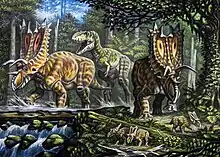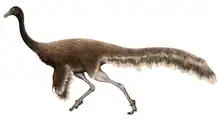| Bistahieversor Temporal range: Late Cretaceous, | |
|---|---|
 | |
| Skull and vertebra at the New Mexico Museum of Natural History and Science | |
| Scientific classification | |
| Domain: | Eukaryota |
| Kingdom: | Animalia |
| Phylum: | Chordata |
| Clade: | Dinosauria |
| Clade: | Saurischia |
| Clade: | Theropoda |
| Clade: | †Eutyrannosauria |
| Genus: | †Bistahieversor Carr & Williamson, 2010 |
| Species: | †B. sealeyi |
| Binomial name | |
| †Bistahieversor sealeyi Carr & Williamson, 2010 | |
Bistahieversor (meaning "Bistahi destroyer"), also known as the "Bisti Beast", is a genus of basal eutyrannosaurian theropod dinosaur. The genus contains only a single known species, B. sealeyi, described in 2010, from the Late Cretaceous[1] of New Mexico. The holotype and a juvenile were found in the Hunter Wash Member of the Kirtland Formation, while other specimens came from the underlying Fossil Forest member of the Fruitland Formation. This dates Bistahieversor approximately 75.5 to 74.5 million years ago during the Campanian age, found in sediments spanning a million years.
Discovery and naming

The first remains now attributed to Bistahieversor, a partial skull and skeleton, were described in 1990 as a specimen of Aublysodon.[2] Additional remains, consisting of the incomplete skull and skeleton of a juvenile, were described in 1992.[3] Another complete skull and partial skeleton were found in the Bisti/De-Na-Zin Wilderness Area of New Mexico in 1998,[4] known colloquially as the "Bisti Beast".[5]
In a 2000 paper, Thomas Carr and Thomas Williamson re-examined these four specimens and suggested that they did not belong to Aublysodon, but rather to one or more new species of Daspletosaurus.[6] However, it was not until 2010 that Carr and Williamson published a thorough re-description of the specimens and found that they belonged to a new genus and species of more generalized tyrannosauroid. They named it Bistahieversor sealeyi.[1] The name Bistahieversor comes from the Navajo Bistahí, or "place of the adobe formations" in reference to the Bisti/De-Na-Zin Wilderness Area where it was found. Eversor, the latter part of the name, means "destroyer."[1]
Description

Material from both juveniles and adults has been found in the Kirtland and Fruitland formations of New Mexico. Adult Bistahieversor are estimated to have been around 9 meters (30 ft) long and weigh at least a ton. The snout is deep, indicating that the feature is not unique to more derived tyrannosaurs, such as Tyrannosaurus. Geographical barriers, such as the newly forming Rocky Mountains, may have isolated the more southerly Bistahieversor from more derived northern tyrannosaurs.[7] In 2010, Gregory S. Paul estimated a length of 8 meters (26 ft) and a weight of 2.5 metric tons (2.75 short tons).[8] In 2016, Molina-Pérez and Larramendi gave a length of 9 meters (29.5 ft) and a weight of 3.3 metric tons (3.6 short tons).[9]
Bistahieversor differs from other tyrannosaurs in the possession of 64 teeth, an extra opening above the eye, and a keel along the lower jaw, among many other unique traits. The opening above the eye is thought to have accommodated an air sac that would have lightened the skull's weight. Bistahieversor also had a complex joint at its "forehead" that would have stabilized the skull to prevent movement at the joint.[10]
Classification


Bistahieversor is a genus of derived tyrannosaur currently classified in the subfamily Tyrannosaurinae. It is more derived than Teratophoneus, but less derived than Lythronax.[11] It forms the sister taxon of a group that includes Lythronax, Nanuqsaurus, Tyrannosaurus, Tarbosaurus, and Zhuchengtyrannus.[12]
Below is a cladogram illustrating the relationships of all tyrannosaurid genera:[12]
| Tyrannosauridae |
| ||||||||||||||||||||||||||||||||||||||||||||||||||||||||||||
The cladogram below is based on a phylogenetic analysis conducted by Voris et al. in 2020. Here, Bistahieversor was recovered as a basal member of Eutyrannosauria alongside Dryptosaurus and Appalachiosaurus instead of as a tyrannosaurine:[13]
| Eutyrannosauria |
| ||||||||||||||||||||||||||||||||||||||||||||||||||||||||||||||||||||||||||||||||||||||||||||||||||||||||||||
Paleobiology

A 2020 study of the endocranial morphology of Bistahieversor shed some light on its hunting behaviors. Its large olfactory bulbs indicate a very heightened sense of smell, while the elongated semi-circular canals implied increased agility and sophisticated gaze stabilization while the head was moving. Bistahieversor also possessed binocular vision, allowing it to see much better than more primitive predatory dinosaurs. The study noted that, while Bistahieversor had small optic lobes, this was not a strong indicator of whether or not this dinosaur possessed poor vision.[14]
See also
References
- 1 2 3 Carr, Thomas D.; Williamson, Thomas E. (2010). "Bistahieversor sealeyi, gen. et sp. nov., a new tyrannosauroid from New Mexico and the origin of deep snouts in Tyrannosauroidea". Journal of Vertebrate Paleontology. 30 (1): 1–16. doi:10.1080/02724630903413032. S2CID 54029279.
- ↑ Lehman, Thomas M.; Carpenter, Kenneth (November 1990). "A partial skeleton of the tyrannosaurid dinosaur Aublysodon from the Upper Cretaceous of New Mexico". Journal of Paleontology. 64 (6): 1026–1032. doi:10.1017/S0022336000019843. JSTOR 1305741. S2CID 132662000.
- ↑ Archer, Brad; Babiarz, John P. (July 1992). "Another tyrannosaurid dinosaur from the Cretaceous of northwest New Mexico". Journal of Paleontology. 66 (4): 690–691. doi:10.1017/S0022336000024598. S2CID 130535722.
- ↑ "New Species of Tyrannosaur Discovered in Southwestern U.S." Newswise. January 28, 2010. Retrieved February 1, 2010.
- ↑ "ABQJOURNAL NEWS/STATE: N.M. Tyrannosaur Is Officially Dubbed Bistahieversor sealeyi". www.abqjournal.com. Retrieved January 27, 2017.
- ↑ Carr, Thomas D.; Williamson, Thomas E. (2000). "A review of Tyrannosauridae (Dinosauria: Coelurosauria) from New Mexico". Bulletin. New Mexico Museum of Natural History and Science. 17: 113–145.
- ↑ Rettner, Rachael (January 28, 2010). "New Tyrannosaur Species Discovered". LiveScience. Retrieved February 1, 2010.
- ↑ Paul, Gregory S. (2010). The Princeton Field Guide to Dinosaurs. Princeton University Press. p. 103.
- ↑ Molina-Pérez & Larramendi (2016). Récords y curiosidades de los dinosaurios Terópodos y otros dinosauromorfos. Barcelona, Spain: Larousse. p. 265.
- ↑ Viegas, J. (January 28, 2010). "New Tyrannosaur Had More Teeth Than T. rex". Discovery News. Retrieved February 1, 2010.
- ↑ Loewen, Mark A.; Irmis, Randall B.; Sertich, Joseph J. W.; Currie, Philip J.; Sampson, S. D. (2013). Evans, David C (ed.). "Tyrant Dinosaur Evolution Tracks the Rise and Fall of Late Cretaceous Oceans". PLoS ONE. 8 (11): e79420. Bibcode:2013PLoSO...879420L. doi:10.1371/journal.pone.0079420. PMC 3819173. PMID 24223179.
- 1 2 Fiorillo, Anthony R.; Tykoski, Ronald S. (2014). Dodson, Peter (ed.). "A Diminutive New Tyrannosaur from the Top of the World". PLoS ONE. 9 (3): e91287. Bibcode:2014PLoSO...991287F. doi:10.1371/journal.pone.0091287. PMC 3951350. PMID 24621577.
- ↑ Voris, Jared T.; Therrien, Francois; Zelenitzky, Darla K.; Brown, Caleb M. (2020). "A new tyrannosaurine (Theropoda:Tyrannosauridae) from the Campanian Foremost Formation of Alberta, Canada, provides insight into the evolution and biogeography of tyrannosaurids". Cretaceous Research. 110: 104388. doi:10.1016/j.cretres.2020.104388. S2CID 213838772.
- ↑ McKeown, Matthew; Brusatte, Stephen L.; Williamson, Thomas E.; Schwab, Julia A.; Carr, Thomas D.; Butler, Ian B.; Muir, Amy; Schroeder, Katlin; Espy, Michelle A.; Hunter, James F.; Losko, Adrian S. (2020). "Neurosensory and Sinus Evolution as Tyrannosauroid Dinosaurs Developed Giant Size: Insight from the Endocranial Anatomy of Bistahieversor sealeyi" (PDF). The Anatomical Record. 303 (4): 1043–1059. doi:10.1002/ar.24374. hdl:20.500.11820/8c657729-91df-4f7c-bca5-b9c469781768. ISSN 1932-8494. PMID 31967416. S2CID 210871038.


.jpg.webp)












